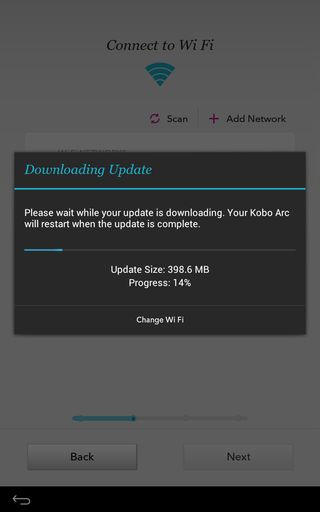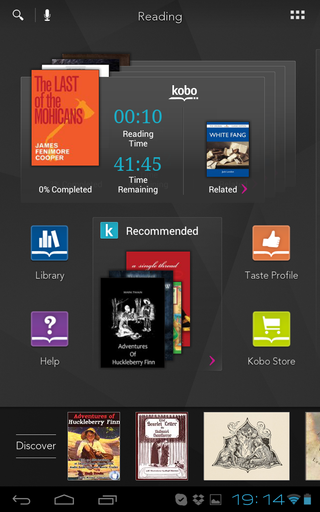Why you can trust TechRadar
Thanks to a firmware upgrade in early April 2013, the Kobo Arc has moved from running Android 4.0 Ice Cream Sandwich to Android 4.1 Jelly Bean.

Because it was a totally open Android interface, all of Jelly Bean's new features can now be found on the Kobo Arc, including Google Now, rich notifications and face unlock.
That last feature is, in practice, hit-and-miss. Perhaps it's the Kobo Arc's low-sensitivity 1.3 megapixel camera that's to blame, but in our test the Kobo Arc only managed to identify our big face in three out of five attempts.
Besides, during the set up process the Kobo Arc warned us that face unlock wasn't as secure as a password. So what's the point of it, then?
The new Jelly Bean keyboard is present, as are various voice-to-text functions that culminate in the appearance of Google Now on the Kobo Arc. It's the most significant change brought to this eReader by Jelly Bean, and it's kick-started by a swipe (upwards from the bottom) of the screen, bringing voice-activated search and local information. In short, it makes the Kobo Arc much more aware of its location.
Despite being a thoroughly open Android device, the Kobo Arc is also heavily modified. All Jelly Bean features remain, but the Kobo Arc adds its own layer into the mix. Called Tapestries, it's mostly concerned with Pinterest-style noticeboard organisation, and learning your preferences.

It's organised around dynamically changing carousel tabs, the default being Reading, Entertainment and Social, though you can create your own. Select Social and you'll see Tweets and Facebook status updates.
Press Entertainment from the home screen and a carousel of videos is enlarged, and added to by shortcuts to YouTube, 7digital, CinemaNow, Gallery, Rdio and Play Music.
Meanwhile, the Reading tapestry displays book covers with 'Reading Life' statistics (time read, remaining time, percentage complete, which seem a little similar to those employed on the Kindle Paperwhite) and a link to your Library, the Kobo Store, and Taste Profile, which shows you book covers; drag them into the yes/no pile and the Arc will learn your preferences.
However, the key point of Tapestries is that any picture, web page, chunk of text, widget or app can be 'pinned' to any of your Tapestry folders.
Down the bottom of all Tapestries pages is Discover, a timeline of thumbnail icons of news stories, books and YouTube videos Kobo thinks you might like.
We're not hugely keen on this idea of 'web concierge', but in practice it works pretty well – and if nothing else this makes sure you don't miss the top news stories from around the world.

It only does this from Kobo's own cache of the web – it's not based on your search history.
A shortcut from the home page leads to the usual Android grid of apps, but also includes a tab of widgets such as a clock, bookmarks and any open apps you might have running.
From here it's a cinch to drag them into any Tapestry; as you touch a widget and move it, the home page reappears, ready to accept 'pins'. The result is that, within Tapestries, the Kobo Arc is totally customisable in terms of content and apps.
Gliding between pages, apps, the web browser and books is always fast, as is the virtual keyboard, though the latter's buttons are rather too small in portrait mode (we frequently made mistakes while typing).
It boots-up very quickly, though when titling the device the Arc is slow to re-orientate between landscape and portrait.
We also noticed that the screen isn't quite as responsive as it should do; tapping the tiny 'x' to kill unwanted adverts on games, for instance, proved tricky, as did some drag and dropping of apps, though the Arc is mostly capable with both the basic Android elements and its own architecture.
Jamie is a freelance tech, travel and space journalist based in the UK. He’s been writing regularly for Techradar since it was launched in 2008 and also writes regularly for Forbes, The Telegraph, the South China Morning Post, Sky & Telescope and the Sky At Night magazine as well as other Future titles T3, Digital Camera World, All About Space and Space.com. He also edits two of his own websites, TravGear.com and WhenIsTheNextEclipse.com that reflect his obsession with travel gear and solar eclipse travel. He is the author of A Stargazing Program For Beginners (Springer, 2015),


